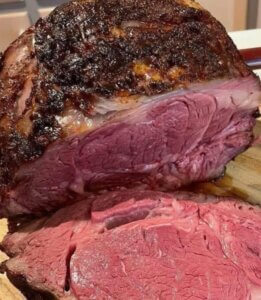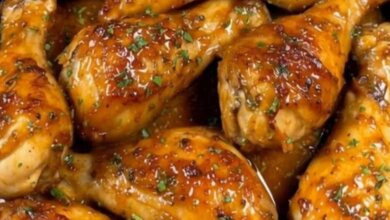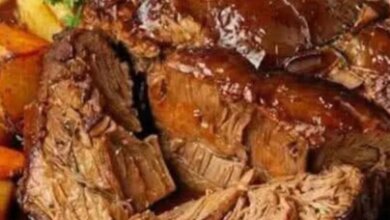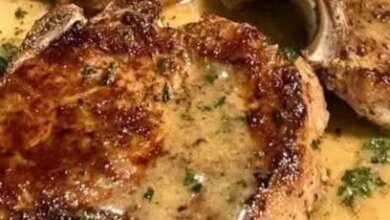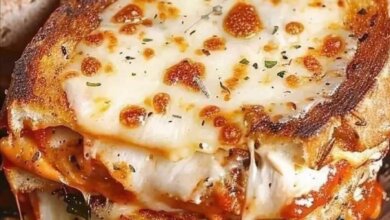
Introduction
The Perfect Prime Rib Roast is a show-stopping centerpiece, renowned for its juicy tenderness, marbled flavor, and impressive presentation. This luxurious cut of beef — also known as standing rib roast — delivers a rich, buttery taste with a crisp, herb-crusted exterior and a perfectly pink, melt-in-your-mouth interior. Whether it’s a festive holiday meal, a Sunday dinner, or a celebratory feast, this dish embodies culinary sophistication and warmth.
—
Origin and Cultural Significance
Prime rib, deeply rooted in British and American culinary traditions, traces its origins to 19th-century England, where roasting large cuts of meat became a hallmark of festive Sunday meals. As British settlers spread their cooking customs, the dish evolved into a North American holiday staple — symbolizing prosperity, generosity, and family togetherness.
In modern cuisine, prime rib remains a culinary icon of celebration, served during Christmas, Thanksgiving, and special occasions. Its enduring appeal lies in the artistry of simple ingredients, precise roasting, and respect for high-quality beef.
—
Ingredients Quantity
(Serves 6–8 people)
1 (4–5 lb / 1.8–2.3 kg) bone-in prime rib roast
2 tablespoons olive oil or softened butter
1 tablespoon kosher salt
1 tablespoon freshly cracked black pepper
4 cloves garlic, minced
2 teaspoons fresh rosemary, finely chopped
2 teaspoons fresh thyme leaves
1 teaspoon onion powder (optional but enhances savoriness)
—
Optional Additions
1 teaspoon Dijon mustard – adds tangy depth to the rub
2 teaspoons smoked paprika – for subtle smokiness
1 tablespoon horseradish – classic pairing for serving
Red wine reduction or au jus – for an elegant finish
Fresh herbs for garnish – rosemary sprigs or thyme
—
Tips for Success
1. Choose a well-marbled roast: Fat equals flavor — marbling ensures tenderness and richness.
2. Bring to room temperature: Let the roast sit out for 2–3 hours before cooking for even roasting.
3. Use a meat thermometer: Essential for achieving your desired doneness without overcooking.
4. Start hot, finish low: Begin with high heat to sear, then lower the oven to roast gently.
5. Let it rest: Allow at least 20–30 minutes of resting after roasting — juices will redistribute, creating the perfect texture.
6. Do not cover while resting: Keeps the crust crisp and prevents steaming.
—
Instructions
Step 1: Prepare the Roast
Remove the prime rib from the fridge 2–3 hours before cooking.
Pat dry with paper towels. Rub with olive oil (or butter), garlic, salt, pepper, rosemary, and thyme.
Step 2: Preheat the Oven
Preheat oven to 450°F (230°C).
Step 3: Roast at High Heat
Place the rib roast, bone side down, on a roasting rack in a shallow pan.
Roast at 450°F (230°C) for 15–20 minutes to form a golden crust.
Step 4: Lower the Temperature
Reduce oven temperature to 325°F (165°C).
Continue roasting until the internal temperature reaches:
120°F (49°C) for rare
130°F (54°C) for medium-rare
140°F (60°C) for medium
(Approx. 15–20 minutes per pound, depending on your oven and doneness preference.)
Step 5: Rest
Transfer roast to a cutting board. Loosely tent with foil and rest for 20–30 minutes before carving.
Step 6: Serve
Slice between bones for classic presentation. Serve with au jus, horseradish cream, or a red wine reduction.
—
Description
The Perfect Prime Rib Roast is a masterpiece of contrasts — a beautifully caramelized crust enveloping tender, rosy beef that’s juicy and flavorful with every slice. The aroma of roasted garlic and herbs fills the air, and the first bite reveals a balance of buttery fat, savory seasoning, and natural beef essence. It’s a sensory celebration of flavor, texture, and craftsmanship.
—
Nutritional Information (per serving, approx. 8 servings):
Calories: ~480 kcal
Protein: 34 g
Fat: 38 g
Carbohydrates: 1 g
Cholesterol: 115 mg
Sodium: 580 mg
Iron: 20% DV
(Values vary depending on size, trimming, and cooking method.)
—
Conclusion
The Perfect Prime Rib Roast is more than a meal — it’s a tradition, a statement of care, and a triumph of simplicity done right. With just a handful of ingredients and mindful technique, you can create a dish that embodies elegance, comfort, and celebration in every bite.
—
Recommendation
Pair your prime rib with garlic mashed potatoes, roasted vegetables, or Yorkshire pudding for a classic ensemble. A bold red wine like Cabernet Sauvignon or Syrah complements its richness beautifully. For a refined finish, drizzle with pan juices or horseradish cream sauce.
—
Embracing Healthful Indulgence
While undeniably indulgent, prime rib can be enjoyed mindfully. Choosing grass-fed beef provides higher omega-3s and better fat balance, while roasting preserves nutrients without heavy oil use. Complementing it with fiber-rich vegetables and moderate portions makes it both wholesome and satisfying.
The true health in this dish comes not just from ingredients, but from slow cooking, shared meals, and conscious enjoyment — savoring the art of food and fellowship.
